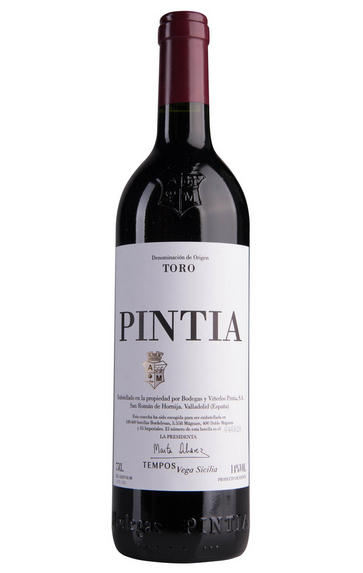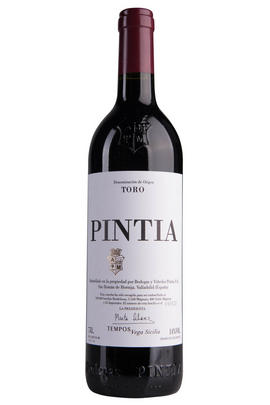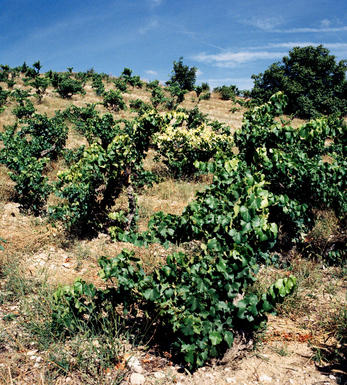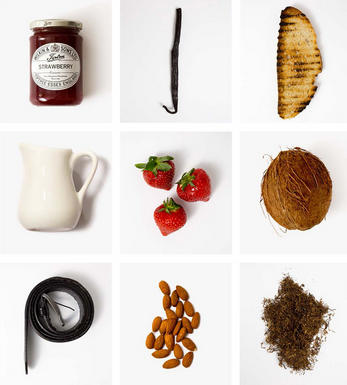
2005 Bodegas Pintia, Toro, Spain

Critics reviews
Comparing the 2005 Pintia against the 2004, I prefer the aromatics of the 2005, which are beautiful – pure, lifted red fruit, briar, a touch of smoke and minerals. The palate is very well-balanced with supple, ripe tannins and fine acidity. There is plenty of red-berry fruit here, lending the 2005 an attractive fleshy texture, although there is something slightly foursquare about the finish, with hints of spice, black tea, and cracked black pepper in the aftertaste. Still, this is the best of the mature Pintia wines.
Neil Martin, Vinous.com
Inky purple. An alluring bouquet of blackberry and blueberry preserves, cherry cola and vanillin oak spices. Broad, fleshy and deep, with sweet flavours of dark berries, floral pastille and vanilla beans. The rich fruit nicely absorbs the oak element on the long, velvety finish. Leaves a wide swath of creamy dark fruits and licorice in its wake. It's pretty sexy stuff.
Josh Raynolds, Vinous.com (July 2008)
100% Tinta de Toro aged 12 months in 100% new oak (70% French, 30% US).
A delicate note of vanilla mingles with the smoky dark fruit. Youthful tannins are firm yet still seem to melt in your mouth like chocolate. Minerally and fresh to the end, even though there is considerable richness and weight.
Ready to drink
Julia Harding MW, JancisRobinson.com (January 2008)
Bodegas Pintia is owned by Vega Sicilia. Pintia is located further west along the Duero River inside the warmer D.O. of Toro. The estate owns 96 hectares of land. The first vintage released was the 2001. As for the 2005 Pintia, it is 100% Tinta de Toro aged for one year in new French and American oak. Opaque purple-coloured, it offers a complex perfume of pain grille, pencil lead, spice box, black cherry, and blackberry. This leads to a full-bodied, ripe, layered wine with intense flavours, serious complexity, and exceptional length.
It has enough structure to unfold for another 4-6 years and drink well through 2025.
Jay S Miller, Wine Advocate (February 2008)
Very young but exuberant and balanced. Tasted in Spain well after bottling but before its March 2008 release, Pintia, Vega Sicilia's Toro project, comes across as a bull of a wine with huge levels of color and extraction. Floral, mineral and violet aromas lead off, followed by deep berry fruit flavors and lots of rustic charred beef on the finish. Hold until 2009 and drink through 2014.
Michael Schachner, Wine Enthusiast (June 2008)
About this WINE

Bodegas Pintia
Vega Sicilia’s owners, the Álvarez family, bought Bodegas Pintia in 1996, attracted to the galet-strewn terroir in the northern Spanish region of Toro, the rich clay subsoils and the familiar altitude. They decided to produce an alternative expression of Vega Sicilia’s style of Tinto Fino (Tempranillo) from this site.
Toro’s main point of difference to Ribera del Duero is the ambient temperature, which can blaze in the height of summer. The challenge here is to match concentration with elegance, a challenge met by Bodegas Pintia with no shortage of aplomb.

Toro
The wine region of Toro is a predominantly red-wine appellation in Castilla y León in north-western Spain. Toro is situated in the province of Zamora, west of the Rueda and Ribera del Duero wine appellations, and in the Spanish Duero river valley near the Portuguese border.
The Toro appellation covers approximately 5,600 hectares of vineyards at an altitude of 600 to 750 metres above sea level. The region produces red wine across the spectrum from Joven to Gran Reserva, but all grades must be made from at least 75 percent Tinta de Toro (the local name for a clone of the Tempranillo red grape). The best reds tend to contain 100 percent Tinta de Toro and are robust, concentrated and well-structured.
Cabernet Sauvignon is also planted in the region, but not permitted for its DO wines. White wines constitute only a small proportion of Toro production and are made from Malvasía and Verdejo.Toro made its breakthrough when some of the greatest names in the Spanish winemaking scene showed their trust in the region's potential, and moved on to establish their own estates there. These included Vega Sicilia's Álvarez family, Rioja's Marqués de Riscal and Mariano García (the former Vega Sicilia winemaker) with its new Toro winery Mauro-dos.
Jacques and François Lurton of Bordeaux also launched a winery (El Albar) in Toro, where they're making wine both alone and in partnership with renowned oenologist Michel Rolland (at his Campo Elíseo). In Valdefinjas, Rioja's Eguren family of Bodegas Sierra Cantabria has Numanthia-Termes, which makes Termanthia and Numanthia, two of the most well-known wines in the region today.

Tempranillo/Tinto Fino
A high quality red wine grape that is grown all over Spain except in the hot South - it is known as Tinto Fino in Ribera del Duero, Cencibel in La Mancha and Valdepenas and Ull de Llebre in Catalonia. Its spiritual home is in Rioja and Navarra where it constitutes around 70% of most red blends.
Tempranillo-based wines tend to have a spicy, herbal, tobacco-like character accompanied by ripe strawberry and red cherry fruits. It produces fresh, vibrantly fruit driven "jovenes" meant for drinking young. However Tempranillo really comes into its own when oak aged, as with the top Riojas where its flavours seem to harmonise perfectly with both French and American oak, producing rich, powerful and concentrated wines which can be extraordinarily long-lived.
In Ribera del Duero it generally sees less oak - the exception being Vega Sicilia where it is blended with Cabernet Sauvignon and Merlot and then aged for an astonishing 7 years in oak and is unquestionably one of the world`s greatest wines.


Buying options
Add to wishlist
Description
Where the Duero is about to become the Douro and Spain cedes to Portugal, we find Toro's arid, forthright vineyards, its evocative name appropriate given the rugged terrain and the power of the wines. The Pintia vineyard is strewn with poppies and pudding stones; one could almost be in Châteauneuf du Pape here were it not for the distinctive subsoil of red clay. The stewardship of Vega Sicilia has brought expertise and investment, but the character has not been lost.
Tempranillo is known as Tinta de Toro in these parts of Spain; at 50 years of age, these vines have had to dig deep to nourish and moisten the wines in the brutal heat of 2005. The wine has been aged for 23 months in new oak (70% French, 30% American); its haunting aromas of violets, plums and charcuterie almost remind me of Quinta Do Vesuvio (not that far away, after all). Dark brooding fruits, liquorice, tar and undergrowth on the palate, balancing acidity and robust but not astringent tannins. One for the longer term, indeed; one to watch without any doubt at all.
Berry Bros. & Rudd
wine at a glance
Delivery and quality guarantee